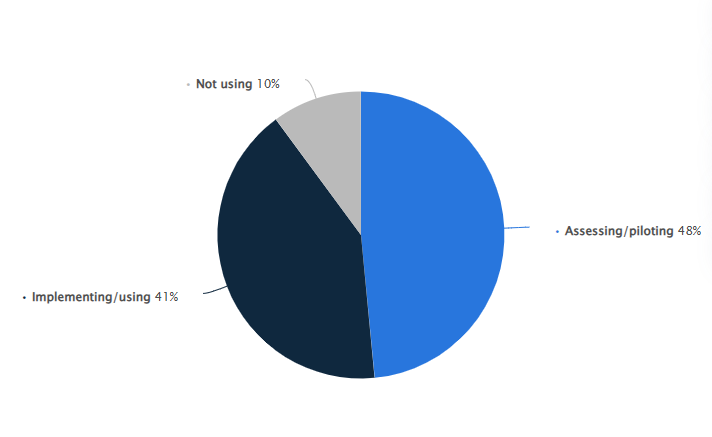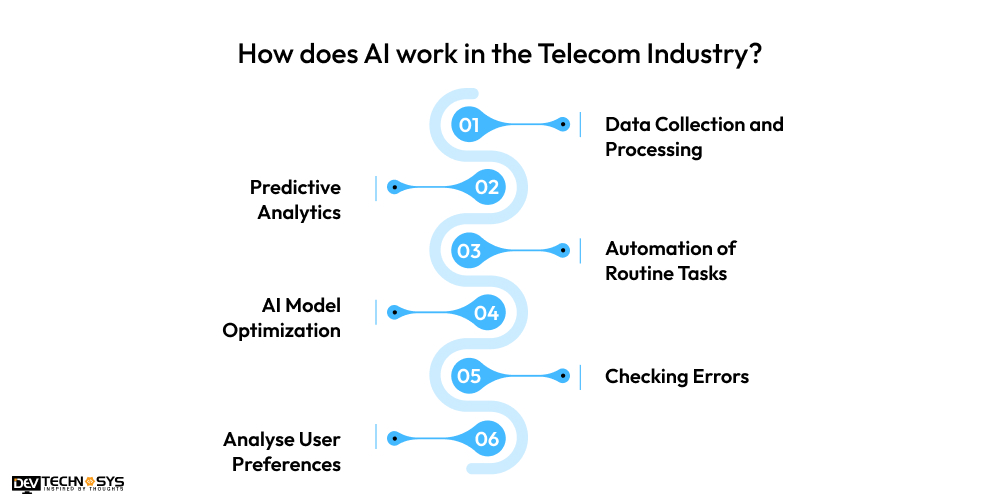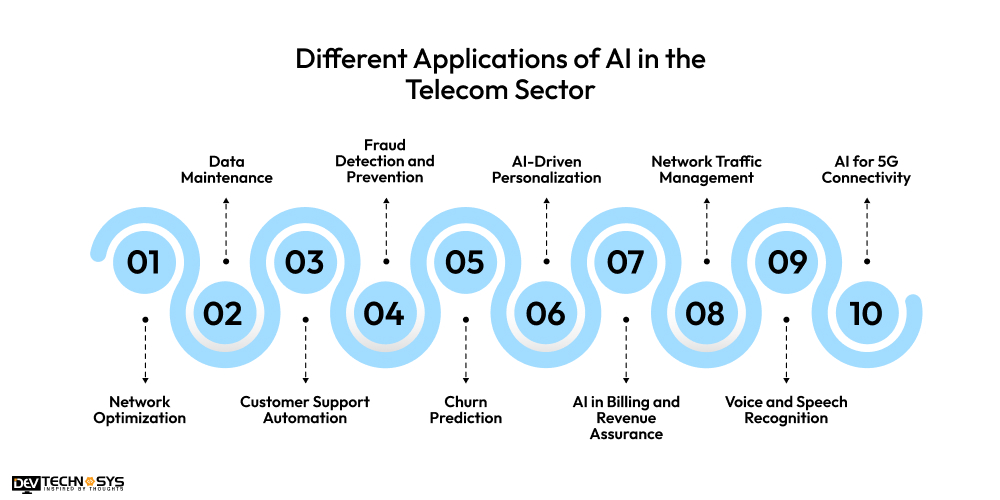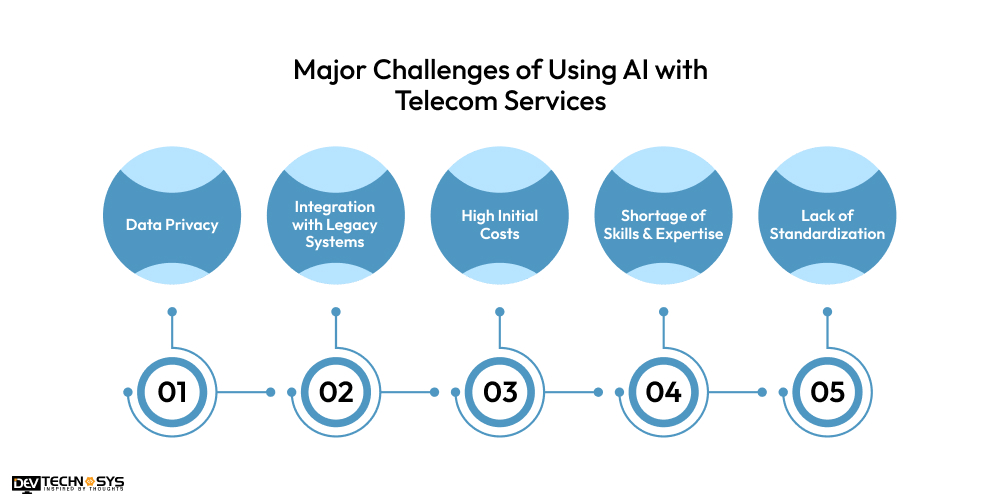“Boost communication with AI and its applications in the modern Telecom sector.”
Various technologies like Blockchain, Cloud Computing and Artificial Intelligence have a lot of applications and scope in different industries. They are transforming these domains with the use of specialized tools that are dedicated to particular industries. Similarly, the implementation of AI in Telecom has turned the sector into self-reliant and fast growing.
Presently, the telecom industry is in a phase of transformation due to the extensive use of AI. Additionally, other technologies are also contributing a little bit to this sector. The impact and use of AI in telecom industry has made it easy to attract users in large numbers for businesses.
The fact is that due to the newness of this technology, it is difficult for investors to easily accept the change. So, to make this task easy, we are looking at different aspects like benefits, applications, future scope, and challenges of AI in Telecoms in this blog. Let us proceed to understand more.
What is the Current Telecom Market?
According to Statista, 41% of Telecom businesses stated that they were either utilizing or in the process of deploying Artificial Intelligence in 2023. Additionally, 48% stated that they were evaluating or piloting AI integration.

The size of the global AI in the telecommunication industry was estimated at $2.36 Billion in 2023 based on a report published by Fortune Business Insights. It is expected to increase at a compound annual growth rate of 43.1% CAGR from $3.34 Billion in 2024 to $58.74 Billion by 2032.
Why Choose AI for Telecom Business?
AI is becoming a game-changer for telecom businesses, offering immense potential to streamline operations, improve customer experience, and drive innovation. By combining AI with IT consulting services, telecom companies can optimize network management, reduce operational costs, and enhance data-driven decision-making.
AI can automate routine tasks, offer personalized services to customers, and predict future network demands, making it a crucial tool for staying competitive. In addition the role of AI in telecom industry is to help telecom businesses identify patterns, detect anomalies, and proactively address issues, improving efficiency and customer satisfaction.
- AI automates tasks and enhances operational efficiency, reducing manual labor and operational costs.
- Various AI-driven chatbots and virtual assistants provide faster, personalized support to customers.
- This technology optimizes network performance by detecting issues and ensuring smooth operations.
- Businesses can anticipate and resolve issues before they impact service, improving uptime with the help of AI.
- It is easy to analyze vast amounts of data to uncover patterns and trends, enabling better decision-making through AI.
Based on a report submitted by Precedence Research, the North America market has accounted for 35% of the global AI in the telecom industry.
What are the Benefits of Using AI for Telecom?
AI is revolutionizing the telecom industry by enhancing network performance, customer service, and operational efficiency. By adopting AI, telecom businesses can unlock new opportunities and stay ahead of the competition. Here are some key benefits of AI in Telecom that businesses should know.

1. Enhanced Customer Experience
AI enables telecom companies to deliver personalized services by analyzing customer data and predicting needs. Virtual assistants, chatbots, and automated responses provide round-the-clock customer support, improving satisfaction and engagement. It is easy to create an AI app with recommendations and issue resolution to speed up interactions, leading to higher customer retention.
Implement AI chatbots and recommendation systems for personalized and immediate customer interactions.
2. Improved Network Efficiency
AI can optimize network operations by predicting demand, detecting faults, and managing network traffic. Automated issue resolution and proactive maintenance help reduce downtime, ensuring smooth operations. AI ensures that telecom networks adapt quickly to changing traffic conditions, improving overall performance.
Use AI-powered network management tools that analyze data in real time to adjust network resources automatically.
3. Cost Reduction
AI automates various processes such as customer support, troubleshooting, and network monitoring, reducing the need for manual interventions. By minimizing human labor and optimizing resource allocation, telecom companies can significantly cut costs. Predictive maintenance further helps in avoiding costly repairs by preventing issues before they arise.
Integrate AI-driven automation tools into your telecom business to handle routine tasks and reduce operational expenses.
4. Ensure Privacy
AI analyzes user behavior and transaction data to identify unusual patterns and detect fraudulent activities. By using AI in web development you can easily monitor network traffic and user actions, to prevent identity theft, service fraud, and unauthorized access. Real-time alerts ensure quick intervention before significant damage is done.
Deploy AI-based fraud detection systems to continuously monitor network usage and flag suspicious activities in real time.
5. Regularize Data
AI-powered systems can predict potential network failures by analyzing historical data and identifying patterns that indicate wear or failure. Predictive maintenance ensures that telecom infrastructure is serviced proactively, reducing downtime and improving network reliability. This helps prevent costly disruptions and extends equipment lifespan.
Use AI-driven analytics and sensors to monitor infrastructure health and predict maintenance needs ahead of time.
6. Optimized Resource Management
AI helps telecom companies better allocate resources by analyzing network data and user behavior patterns. By predicting demand surges and monitoring traffic flow, AI ensures that network resources are used optimally, avoiding overloading and underutilization. This optimizes cost efficiency and improves service quality.
Leverage AI tools that monitor resource usage in real time and adjust allocations to avoid bottlenecks or shortages.
7. Enhanced Security
AI-driven security systems can detect and prevent cyber threats in real-time by analyzing patterns and identifying anomalies in network traffic. Machine learning algorithms continuously evolve, improving their ability to spot new threats. You can develop an AI call center platform to enhance overall network security and help protect sensitive customer data.
Integrate AI security solutions that monitor network traffic, identify vulnerabilities, and prevent cyber attacks before they cause harm.
8. Improved Customer Support Automation
AI-powered virtual agents can handle a wide variety of customer queries and service requests automatically, providing immediate assistance. These systems learn over time, becoming more efficient at resolving issues, which reduces wait times and improves customer satisfaction. AI adoption in Telecom also allows businesses to scale support without increasing costs.
Implement AI-driven customer support tools like virtual assistants and automated response systems to handle high volumes of queries.
9. Advanced Data Analytics
AI enhances data analytics by processing and analyzing large amounts of data faster than traditional methods. Telecom companies can gain actionable insights into customer behavior, service performance, and market trends. These insights help in decision-making, improving offerings, and identifying new business opportunities.
Use AI analytics platforms to analyze customer data, forecast trends, and optimize service offerings based on actionable insights.
10. Better Market Segmentation
AI helps telecom companies analyze customer data to identify distinct market segments based on behaviors, preferences, and needs. By hiring an ML development company having tailored marketing strategies and personalized offers, telecom businesses can increase customer loyalty and sales. AI makes segmentation more precise and actionable.
Leverage AI-powered analytics tools to segment customers based on their usage patterns and preferences for targeted marketing.
How does AI work in the Telecom Industry?
AI is transforming the telecom industry by automating processes, improving customer experiences, and optimizing network performance. Through data-driven insights and intelligent systems, AI enables telecom companies to operate more efficiently and effectively.

1. Data Collection and Processing
AI begins by gathering vast amounts of data from various sources like network usage, customer behavior, and service requests. It processes this data in real-time to derive meaningful patterns and insights. This step is critical for feeding AI models that drive decision-making and automation.
2. Predictive Analytics
AI uses historical data through Predictive Analytics services to predict future trends such as customer behavior, network demand, and potential service disruptions. This predictive capability helps optimize resource management and network performance. According to Grand View Research, the consumer analytics segment has the highest revenue share which was 28.2% in 2022.
3. Automation of Routine Tasks
AI automates repetitive tasks such as ticket management, troubleshooting, and basic customer queries. By using chatbots and virtual agents, AI reduces the need for human intervention, freeing up staff for more complex tasks. This increases operational efficiency and cuts costs for telecom companies.
4. AI Model Optimization
AI continuously monitors network performance and makes real-time adjustments to optimize bandwidth, reduce congestion, and improve service delivery. You must approach a Generative AI development company who can predict traffic patterns, identify bottlenecks, and automatically reroute traffic to ensure seamless network operations. This optimizes user experience and reduces downtime.
5. Checking Errors
AI monitors network traffic and customer behavior to detect fraudulent activities such as identity theft or unauthorized service access. By analyzing patterns, AI can identify anomalies in real-time, providing telecom operators with immediate alerts to prevent financial loss. This enhances the security of telecom services.
6. Analyse User Preferences
AI enables personalized customer service by analyzing customer data and predicting their needs, offering tailored recommendations and support. Virtual assistants and chatbots made through AI development services provide instant, 24/7 assistance, improving user satisfaction. AI also helps telecom companies address issues quickly, boosting customer retention and loyalty.
Different Applications of AI in the Telecom Sector
AI is transforming the telecom sector by enhancing efficiency, improving customer experience, and optimizing network operations. Below are 10 different applications of AI in Telecom, showcasing how it is revolutionizing the industry.

1. Network Optimization
AI helps telecom companies optimize network performance by analyzing real-time data and predicting traffic patterns. It can automatically adjust bandwidth, prioritize traffic, and reduce congestion. Multiple AI trends can optimize a seamless user experience and improve overall network reliability.
Features
- Real-time traffic analysis and adjustments.
- Automated resource allocation based on demand.
2. Predictive Maintenance
AI predicts potential network failures and issues before they occur, allowing telecom companies to perform proactive maintenance. By analyzing historical data, Generative AI in Telecom identifies patterns that indicate impending hardware failure or network disruptions, reducing downtime.
Features
- Predictive failure analysis based on historical data.
- Proactive scheduling of maintenance activities.
3. Customer Support Automation
Businesses should know the cost to build an Artificial Intelligence project like AI-driven chatbots and virtual assistants that can provide 24/7 customer support. This reduces the wait times, improves customer satisfaction, and allows human agents to focus on more complex issues.
Features
- Instant responses to customer queries.
- Ability to handle multiple languages and queries simultaneously.
4. Fraud Detection and Prevention
AI monitors network activity for irregularities and anomalies that may indicate fraudulent behavior, such as unauthorized access or service misuse. Implementation of AI in telecom use cases can analyze vast amounts of data in real-time to identify suspicious patterns and prevent financial losses.
Features
- Real-time anomaly detection.
- Alerts for potential fraud and unauthorized access.
5. Churn Prediction
AI analyzes customer behavior to predict which customers are likely to churn, helping telecom companies take proactive steps to retain them. By understanding patterns such as service dissatisfaction, AI can prompt targeted retention strategies, such as personalized offers.
Features
- Customer behavior analysis for churn prediction.
- Customizable retention strategies based on AI insights.
6. AI-Driven Personalization
An AI development company can enhance customer experience by delivering personalized content, recommendations, and offers. It analyzes data such as usage patterns, preferences, and demographics to offer tailored solutions that meet individual customer needs, increasing engagement and loyalty.
Features
- Customized service recommendations based on user behavior.
- Tailored offers and promotions to specific customer segments.
7. AI in Billing and Revenue Assurance
This AI use case in Telecom optimizes the billing process by identifying discrepancies and ensuring accurate charges. AI and Machine Learning in Telecom uses predictive analytics to detect revenue leakage and minimize errors in billing, enhancing transparency and customer trust.
Features
- Automated billing accuracy checks.
- Detection of potential revenue leakage or fraud.
8. Network Traffic Management
Among various AI applications in Telecom, it helps businesses to manage and balance network traffic by analyzing data in real time. It ensures that network resources are efficiently allocated, especially during high-traffic periods, and helps reduce latency, improving service quality.
Features
- Dynamic adjustment of traffic flow to prevent congestion.
- Real-time network resource allocation.
9. Voice and Speech Recognition
AI enhances customer service by enabling voice assistants to understand and respond to customer queries via natural language processing solutions. It also helps automate transcription, voice commands, and call routing, streamlining the service process.
Features
- Natural language understanding for voice-based interactions.
- Automated call routing based on voice commands.
10. AI for 5G Connectivity
This is one of the best AI use cases in Telecom with a critical role in optimizing 5G networks by managing complex connections and traffic. It supports the deployment of 5G infrastructure, ensuring efficient management of resources and enhancing user experience in ultra-high-speed networks.
Features
- Optimization of 5G resource allocation.
- Real-time network management for faster connectivity.
What are the Future Trends of AI in Telecom?
The future of AI in telecom industry gets brighter by enabling smarter operations and enhancing customer experiences. Here are seven future trends of AI and ML in Telecom industry that are expected to shape the industry in the coming years.

1. 5G Network Optimization
AI will play a key role in managing the complexity of 5G networks by optimizing resource allocation, ensuring high-speed connections, and enhancing the overall user experience. It will help telecom companies handle massive data traffic and ensure minimal latency in 5G networks.
Improvement Factors
- Enhanced real-time management of 5G traffic.
- Improved user experience with faster and more stable connections.
2. Autonomous Networks
Autonomous Networks are the future of AI development that enable fully automated telecom networks that can self-manage, monitor, and optimize operations. This will reduce the need for human intervention, increase operational efficiency, and improve network uptime.
Improvement Factors
- Reduced manual monitoring and intervention.
- Faster network issue detection and resolution.
3. Customer Experience Enhancement
AI will continue to improve customer experience by offering more advanced personalization through AI-powered chatbots, virtual assistants, predictive analytics, and Gen AI in telecom industry. Telecom companies will be able to deliver highly tailored services based on individual customer data and behavior.
Improvement Factors
- Higher customer satisfaction with tailored support.
- Increased customer retention through personalized service offerings.
4. Network Maintenance
AI-powered predictive analytics will forecast potential network failures and optimize maintenance schedules to prevent costly downtimes. The approach to hire AI developers can help you to improve network reliability and extend the lifespan of telecom infrastructure.
Improvement Factors
- Increased network reliability with proactive maintenance.
- Reduced unplanned downtime and maintenance costs.
5. AI-Driven Cybersecurity
As cyber threats become more sophisticated, Generative AI in Telecom industry security by identifying anomalies in real-time and preventing breaches. AI will help telecom companies implement adaptive and autonomous security measures, minimizing risks to sensitive data.
Improvement Factors
- Real-time threat detection and rapid response.
- Enhanced protection of customer and company data.
6. Telecom Data Monetization
Telecom investors will leverage AI to analyze customer data and generate insights with the help of an Artificial Intelligence development company. They help you to monetize through targeted advertising, personalized services, and new business models. This will open up new revenue streams while maintaining customer trust and privacy.
Improvement Factors
- More effective targeting of marketing campaigns.
- Increased revenue from data-driven service offerings.
7. Virtual Network Functions (VNF)
AI will support the automation and optimization of Virtual Network Functions (VNFs), enabling telecom operators to virtualize network services and manage them more efficiently. This will lead to more flexible and scalable telecom infrastructures that can easily adapt to changing demands.
Improvement Factors
- Increased scalability of network services.
- Lower operational costs through automation and resource optimization.
Major Challenges of Using AI with Telecom Services
While AI offers transformative benefits to telecom services, integrating AI comes with certain challenges that must be addressed for successful implementation. Here are five major challenges and their solutions.

1. Data Privacy and Security
AI systems rely on large volumes of customer data, raising concerns about privacy and security. Ensuring that sensitive information is protected and adhering to regulatory standards is a major hurdle.
i. Solution
Implement strong encryption methods and comply with privacy regulations like GDPR to ensure data security. Regular audits and AI governance frameworks will also help safeguard customer information.
2. Integration with Legacy Systems
Many telecom companies still use outdated infrastructure and legacy systems, making AI integration difficult. The complexity of transitioning to AI powered chatbots can lead to disruption and high costs.
i. Solution
Adopt a phased integration approach by gradually implementing AI solutions into existing systems. Investing in flexible, scalable AI platforms can ease the transition without significant system overhauls.
3. High Initial Costs
The implementation of AI in telecom sector requires significant investment in technology, training, and infrastructure. Small and medium-sized telecom providers may struggle with the high upfront costs of AI adoption.
i. Solution
Consider cloud-based AI solutions to minimize initial infrastructure costs. Collaborating with AI vendors offering scalable solutions can help manage costs and achieve ROI over time.
4. Skill Gaps and Expertise Shortage
AI implementation requires specialized knowledge and expertise, which can be hard to find in the telecom sector. The shortage of a skilled mobile app development company slows down the adoption and effectiveness of AI solutions.
i. Solution
Invest in conversational AI in Telecom for existing staff to bridge the knowledge gap. Partnering with AI solution providers can also help by providing access to expertise without hiring additional full-time specialists.
5. Lack of Standardization
The lack of standardization in AI technologies across the telecom industry can lead to integration issues and inefficiencies. Inconsistent practices and tools can hinder seamless collaboration and scalability.
i. Solution
Promote industry-wide collaboration to establish common standards and best practices. Telecom companies should work with standardization bodies to create frameworks for AI integration and interoperability.
In a Nutshell!!
Now, we have approached the conclusion of our blog. So, we are just going to focus on the outcomes of using AI in Telecom. The following results will going to help business investors becoming the sole distributor of modern Telecommunication services:
- First of all, it will be easy to reduce the risk of fraudulent activities.
- Next, you can implement the 5G spectrum for users with the help of AI.
- Collaborate with small AI startups in the Telecom sector to acquire the whole industry.
- For quick data prediction, you should use AI consulting services with your existing business model.
By observing these outcomes, business investors can surely get inspired to invest their assets in the development of AI infrastructure for the Telecom industry.
FAQs
Q1. How is AI Transforming the Telecom Industry?
AI is revolutionizing telecom by enhancing customer service, optimizing network operations, and enabling predictive maintenance. With AI, telecom companies can analyze vast amounts of data in real time to improve decision-making and personalize services. AI-driven automation also reduces operational costs and improves service quality.
Q2. What are the Main Benefits of AI in Telecom?
AI enables telecom companies to enhance customer experience through personalized services, predictive analytics, and chatbots. It also optimizes network management by automating troubleshooting and improving resource allocation. Additionally, AI helps in detecting fraud and optimizing network capacity, leading to improved efficiency and profitability.
Q3. What are Some Common AI Applications in Telecom?
AI applications in telecom include virtual assistants for customer support, predictive maintenance for network infrastructure, and automated network optimization. AI is also used for real-time traffic analysis, anomaly detection in security systems, and customer churn prediction, allowing telecom operators to respond proactively to service needs.
Q4. What are the Future Trends of AI in the Telecom Sector?
5G and AI Integration: AI will play a crucial role in optimizing and managing 5G networks for enhanced speed and connectivity.
AI-driven Automation: The use of AI for automated customer support and network management will increase, reducing manual intervention.
AI-powered Analytics: Telecom companies will leverage AI to gain deeper insights from massive data sets, enabling better decision-making and tailored service offerings.
Q5. How Does AI Improve Network Performance in Telecom?
Predictive Analytics: AI predicts network congestion or faults, allowing proactive management and optimization.
Self-Optimizing Networks: AI can automatically adjust the network to optimize performance, ensuring minimal downtime and maximum efficiency.
Anomaly Detection: AI algorithms detect unusual patterns or security threats, enabling quicker response times and ensuring network security.
Q6. What Challenges Does AI Face in the Telecom Industry?
Data Privacy: Managing sensitive customer data and ensuring privacy compliance remains a challenge.
Integration Complexity: Integrating AI with existing telecom infrastructure can be complex and time-consuming.
Skill Gaps: Telecom companies may struggle to find and retain skilled professionals capable of implementing AI solutions effectively.

































